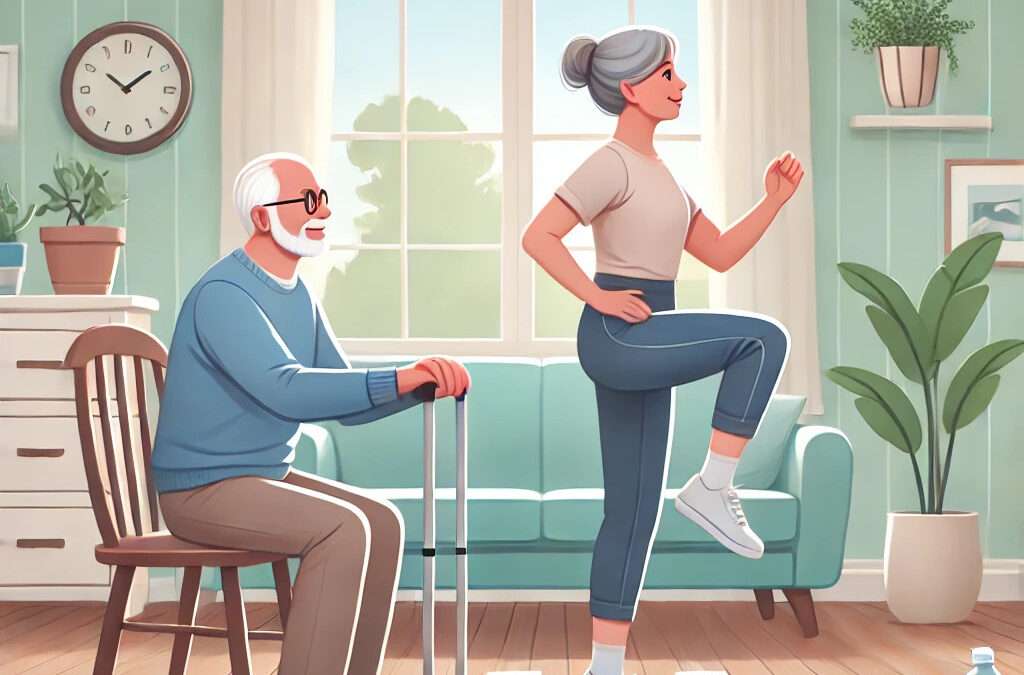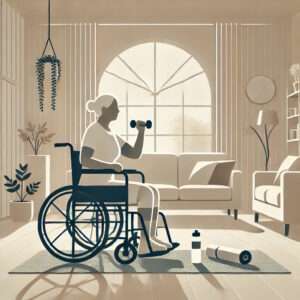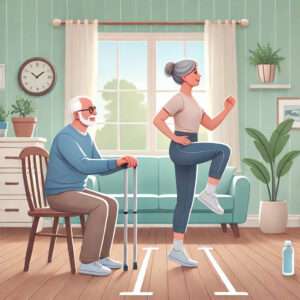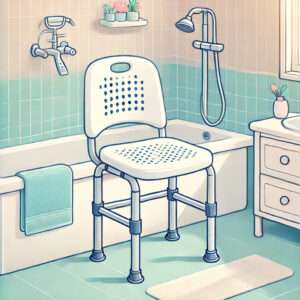I. Introduction
A. The Importance of Balance in Senior Health
Have you ever found yourself feeling a bit unsteady while walking or standing? As we age, maintaining good balance becomes increasingly important. Not only does it help us perform daily activities with ease, but it also plays a crucial role in preventing falls and injuries.
Balance is essential for:
- Walking confidently without the fear of tripping.
- Climbing stairs safely and efficiently.
- Carrying groceries or grandchildren without losing stability.
- Enjoying hobbies like gardening, dancing, or playing sports.
But why does balance tend to decline as we get older? Several factors contribute to this:
- Muscle Weakness: Muscles that support balance can weaken over time if not regularly exercised.
- Vision Changes: Reduced eyesight can affect depth perception and coordination.
- Inner Ear Issues: The inner ear helps control balance, and age-related changes can impact its function.
- Medications: Some medications can cause dizziness or lightheadedness.
Did you know? According to the Centers for Disease Control and Prevention (CDC), one in four Americans aged 65 and older falls each year. Falls are not just minor accidents; they are the leading cause of injury and injury-related deaths among older adults.
B. Common Questions About Balance and Aging
“Is it normal to feel unsteady as I get older?”
Feeling some changes in balance is common, but it’s not something you have to accept passively. There are effective ways to improve your balance and reduce the risk of falls.
“What causes my balance to worsen?”
Factors like inactivity, certain health conditions (e.g., arthritis, Parkinson’s disease), and side effects from medications can all contribute to balance issues.
“Can I really improve my balance at my age?”
Absolutely! With regular practice of balance exercises, many seniors see significant improvements in their stability and confidence.
C. Why We Created This Guide
We understand that the fear of falling can be overwhelming. It might keep you from enjoying activities you love or even moving freely around your home. That’s why we’ve put together “The Ultimate Guide to Balance Exercises for Seniors: Tips for Improving Stability and Preventing Falls.”
Our goal is to provide you with:
- Practical exercises that are easy to follow and can be done at home.
- Safety tips to ensure you exercise confidently and correctly.
- Encouragement to take proactive steps toward better balance.
By incorporating these exercises into your routine, you can:
- Enhance your stability and reduce the risk of falls.
- Boost your confidence in daily activities.
- Maintain your independence and enjoy a higher quality of life.
D. What You’ll Learn
In this guide, we’ll cover:
- Understanding Balance and Its Challenges: Learn how aging affects balance and what common factors contribute to instability.
- Benefits of Balance Exercises: Discover the physical and psychological advantages of regular balance training.
- Getting Started Safely: Find out how to prepare for balance exercises, including consulting with healthcare providers and setting up a safe environment.
- Top Balance Exercises for Seniors: Get step-by-step instructions for exercises that improve balance, strength, and flexibility.
- Creating a Balanced Exercise Routine: Learn how to effectively integrate balance exercises into your weekly schedule.
- Lifestyle Tips to Improve Balance: Explore additional ways to enhance balance through nutrition, home safety modifications, and regular health check-ups.
E. A Personal Invitation
We invite you to join us on this journey toward better balance and a more active, fulfilling life. Whether you’re looking to prevent falls, regain confidence, or stay active, this guide is here to support you every step.
Remember: It’s never too late to start. Small steps can lead to significant improvements. So let’s get started!
Tip: Keep a positive mindset. Improving balance is a gradual process, and consistency is key. Celebrate small victories along the way!
II. Understanding Balance and Its Challenges in Seniors
A. How Aging Affects Balance
Have you ever wondered why maintaining balance seems more challenging as the years go by? Aging brings about natural changes in the body that can impact stability.
1. Muscle Weakness and Loss (Sarcopenia)
- What Happens: After the age of 30, muscle mass begins to decrease gradually if not actively maintained.
- Impact on Balance: Weaker muscles mean less support for bones and joints, making it harder to stay steady.
- Tip: Incorporate strength training exercises to help rebuild muscle mass.
2. Decreased Sensory Abilities
- Vision Changes: Conditions like cataracts or glaucoma can impair sight.
- Example: Difficulty seeing obstacles or changes in terrain can lead to missteps.
- Hearing Loss: Affects the inner ear, which plays a crucial role in balance.
- Did You Know? The vestibular system in your inner ear sends signals to your brain about head movement and position.
- Touch Sensitivity: Reduced sensation in feet due to conditions like diabetes.
- Tip: Regular foot checks can help detect sensory loss early.
3. Joint and Bone Issues
- Arthritis: Causes joint pain and stiffness.
- Impact: Limited joint mobility can affect how you walk and maintain balance.
- Osteoporosis: Weakens bones, making them more susceptible to fractures.
- Fact: Fragile bones can make falls more dangerous.
4. Neurological Changes
- Slower Reflexes: Reaction times decrease with age.
- Example: It may take longer to catch yourself if you trip.
- Cognitive Decline: Conditions like dementia can affect spatial awareness.
- Tip: Mental exercises and staying socially active can help maintain cognitive function.
Common Question: “Is it inevitable that my balance will worsen as I age?”
While some changes are natural, you can take proactive steps to maintain and even improve your balance through regular exercise, healthy eating, and lifestyle adjustments.
B. Common Causes of Balance Issues
Understanding the root causes can help in addressing balance problems effectively.
1. Chronic Health Conditions
- Parkinson’s Disease: Affects movement and muscle control.
- Impact: This can lead to shuffling gait and difficulty initiating movement.
- Stroke: This may cause weakness or paralysis on one side of the body.
- Tip: Physical therapy can aid in recovery and improve balance.
2. Medications
- Side Effects: Some drugs can cause dizziness or drowsiness.
- Examples: Blood pressure medications, sedatives, and antidepressants.
- Interactions: Combining certain medications can exacerbate balance issues.
- Tip: Review your medications with your doctor regularly.
3. Inactivity
- Sedentary Lifestyle: This leads to muscle atrophy and decreased coordination.
- Fact: Regular physical activity stimulates muscle growth and improves coordination.
- Fear of Falling: This may cause some to limit their movements, worsening balance over time.
- Tip: Gradually increasing activity levels can build confidence.
4. Environmental Factors
- Home Hazards: Clutter, loose rugs, and poor lighting increase fall risk.
- Solution: Modify your living space to eliminate tripping hazards.
- Improper Footwear: Shoes without proper support can affect stability.
- Tip: Choose footwear with non-slip soles and good arch support.
Common Question: “Can dehydration affect my balance?”
Yes, dehydration can lead to low blood pressure and dizziness, impairing balance. Staying hydrated and drinking plenty of fluids throughout the day is essential.
C. The Impact of Falls
Understanding the consequences of falls underscores the importance of proactive balance care.
1. Physical Consequences
- Injuries: Sprains, fractures, and head injuries are expected results.
- Statistic: Over 95% of hip fractures are caused by falling, usually by falling sideways.
- Reduced Mobility: Injuries can lead to long-term mobility issues.
- Impact: May require the use of walkers or canes, affecting independence.
2. Emotional and Psychological Effects
- Fear of Falling Again can lead to decreased activity and social isolation.
- Cycle: Less activity leads to weaker muscles, increasing fall risk.
- Depression and Anxiety: Reduced independence and fear can affect mental health.
- Tip: Seek support from friends, family, or professionals if feelings of depression arise.
3. Financial Implications
- Medical Costs: Hospital stays, rehabilitation, and long-term care can be expensive.
- Fact: Falls among older adults cost the U.S. healthcare system $50 billion annually.
- Home Modifications: We may need to invest in safety equipment like grab bars and non-slip mats.
Common Question: “What should I do if I experience a fall?”
First, seek medical attention to assess for injuries, even if you feel fine. Then, discuss with your doctor ways to prevent future falls, which may include balance training, vision checks, or medication adjustments.
D. Overcoming Balance Challenges
Awareness is the first step toward improvement.
1. Assessing Your Risk
- Balance Tests: Simple assessments can help determine your balance level.
- Example: Try standing on one foot for 10 seconds while holding onto a stable surface.
- Medical Evaluations: Consult with healthcare providers for comprehensive assessments.
2. Taking Action
- Physical Activity: Engage in exercises specifically designed to improve balance.
- Tip: Tai Chi and yoga are excellent for enhancing stability and coordination.
- Lifestyle Changes: Incorporate healthy habits like proper nutrition and adequate sleep.
- Impact: Overall health improvements can positively affect balance.
3. Seeking Support
- Professional Guidance: Physical therapists can create personalized exercise plans.
- Community Resources: Join local senior centers or groups focused on active living.
- Benefit: Social engagement promotes mental well-being and encourages consistency.
Common Question: “Are assistive devices helpful, or do they make me more dependent?”
Assistive devices like canes or walkers can provide necessary support and reduce fall risk. Using them doesn’t mean you’re more dependent; it means you’re taking smart steps to stay safe and independent.
Transition to the Next Section:
Now that we’ve explored the factors affecting balance and the challenges that come with aging, you might be wondering how to counter these issues. The good news is that balance exercises offer a practical and effective solution. In the next section, we’ll delve into the numerous benefits these exercises provide, both physically and mentally.
Remember: Understanding why balance changes with age empowers you to take control. With the right knowledge and tools, you can improve your stability and continue to enjoy an active, fulfilling life.
III. Benefits of Balance Exercises
A. Physical Benefits
1. Improved Muscle Strength and Flexibility
Regular balance exercises help strengthen the muscles that support your joints, especially in your legs and core. Stronger muscles provide better support, reducing strain and improving mobility.
- Example: Simple moves like standing on one foot or doing leg raises can build strength over time.
- Tip: Combine balance exercises with stretching to enhance flexibility and prevent muscle tightness.
2. Enhanced Coordination and Reaction Time
As you practice maintaining your balance, your body becomes better at coordinating movements. This means you can react more quickly to prevent a fall if you stumble.
- Did You Know? Better coordination helps in activities like catching yourself if you trip or navigating crowded spaces.
- Tip: Incorporate activities that challenge your coordination, such as gentle dance routines or tai chi.
3. Increased Stability and Posture
Balance exercises promote proper alignment of the spine and improve posture.
- Impact: Good posture reduces back pain and makes walking and standing more comfortable.
- Common Question: “Can improving my balance help with my posture?” Yes! Strengthening core muscles through balance exercises supports better posture.
4. Better Joint Health
Strengthening the muscles around your joints can alleviate pressure on them.
- Example: Strong leg muscles can reduce knee pain by supporting the joint better.
- Tip: Low-impact balance exercises are gentle on the joints while still providing benefits.
B. Psychological Benefits
1. Increased Confidence in Mobility
Knowing you have a good balance boosts your confidence in daily activities.
- Example: Feeling secure while walking on uneven surfaces or climbing stairs without assistance.
- Tip: Practice new exercises in a safe environment to build confidence gradually.
2. Reduced Fear of Falling
Improving your balance lessens the fear of falling, which can often hold you back from being active.
- Impact: Less fear leads to more participation in social activities and hobbies.
- Common Question: “I’m afraid I’ll fall if I try to exercise. What should I do?” Start with exercises near a sturdy chair or wall so you can hold on if needed.
3. Enhanced Mood and Mental Health
Physical activity releases endorphins, the “feel-good” hormones.
- Benefit: Regular exercise can reduce feelings of anxiety and depression.
- Tip: Combine balance exercises with deep breathing for added relaxation.
C. Overall Quality of Life
1. Maintaining Independence
Good balance helps you easily perform daily tasks, allowing you to live independently longer.
- Example: Carrying groceries, reaching high shelves, or getting dressed without assistance.
- Common Question: “Will balance exercises really make a difference in my daily life?” Absolutely! Improved balance makes everyday movements safer and easier.
2. Enjoying Hobbies and Activities
Whether it’s gardening, dancing, or playing with grandchildren, better balance lets you continue doing what you love.
- Tip: Tailor your balance exercises to mimic movements from your favorite activities for added enjoyment.
3. Social Engagement
Participating in group exercises or activities enhances social connections.
- Impact: Social interaction is vital for mental health and can motivate you to stick with your exercise routine.
- Example: Joining a local senior yoga class can provide both physical benefits and new friendships.
D. Testimonials and Success Stories
1. Jane’s Journey to Better Balance
At 72, Jane noticed she was becoming unsteady on her feet. She started doing simple balance exercises at home.
- Her Experience: “After a few weeks, I felt more secure walking around, even on uneven sidewalks. It was like getting a part of my youth back!”
- Tip: Jane started by holding onto a chair for support and gradually challenged herself more.
2. Tom’s Return to Golf
Tom, 68, loved golfing but stopped due to fear of falling.
- His Story: Incorporating balance exercises helped him regain his stability.
- His Advice: “Don’t let fear keep you from activities you enjoy. Working on your balance can open doors you thought were closed.”
E. Scientific Support
Research backs up the benefits of balance exercises.
- Study Highlight: A Journal of Geriatric Physical Therapy study found that seniors who practiced balance exercises reduced their fall risk by 30%.
- Fact: Regular balance training improves proprioception—the body’s ability to sense its position in space—which often declines with age.
Common Question: “Are these benefits proven or just anecdotal?”
They are well-documented. Multiple studies have shown that balance exercises significantly improve stability and reduce the risk of falls among seniors.
F. Frequently Asked Questions
1. “How often should I do balance exercises?”
Aim for at least 2-3 times per week. Consistency is key to seeing improvements.
2. “Do I need special equipment?”
No special equipment is necessary. Many exercises use your body weight. However, items like resistance bands or balance pads can add variety.
3. “Can I start if I’ve never exercised before?”
Yes! Begin with simple exercises and progress at your own pace. Consult your doctor if you have any concerns.
G. Tips for Maximizing Benefits
1. Set Realistic Goals
- Tip: Start with small, achievable goals, like balancing on one foot for 10 seconds.
2. Keep It Fun
- Suggestion: Incorporate music or exercise with friends to make it enjoyable.
3. Monitor Your Progress
- Tip: Keep a journal to note improvements and stay motivated.
Transition to the Next Section:
Feeling inspired by the numerous benefits of balance exercises? Before jumping in, it’s essential to know how to get started safely. In the next section, we’ll guide you through the steps to begin your balance training with confidence and care.
Remember: Improving your balance is a journey that enhances not just your physical stability but also your overall well-being. Every step you take brings you closer to a more confident and independent life.
IV. Getting Started Safely
Embarking on a new exercise routine can be both exciting and a bit daunting, especially when it comes to balance exercises. Safety should always be your top priority. Here’s how to start your journey toward better balance with confidence and care.
A. Consult with Your Healthcare Provider
Before you begin any new exercise program, it’s crucial to talk with your doctor or healthcare professional.
1. Importance of Medical Clearance
- Assessing Health Status: Your doctor can evaluate any medical conditions that might affect your ability to exercise safely.
- Example: Certain exercises may need to be modified if you have high blood pressure or heart issues.
- Medication Review: Some medications can impact balance or cause dizziness.
- Tip: Bring a list of all medications and supplements to your appointment for a thorough review.
2. Personalized Recommendations
- Tailored Advice: Your healthcare provider can suggest specific exercises that are safe and beneficial for you.
- Referrals to Specialists: They may recommend a physical therapist who specializes in balance training.
- Did You Know? Physical therapists can create custom exercise plans based on your needs.
Common Question: “I feel fine; do I still need to see my doctor before starting?”
Yes! Even if you feel healthy, a medical check-up ensures you’re ready to start exercising safely. It’s better to be cautious, especially if it’s been a while since you last exercised.
B. Assessing Your Current Fitness Level
Understanding where you stand physically helps in setting realistic goals and tracking progress.
1. Simple Balance Tests
- One-Leg Stand Test: See how long you can stand on one foot without support.
- Tip: Try this near a countertop or sturdy chair in case you need support.
- Timed Up and Go Test: Measure how long it takes to stand up from a chair, walk a short distance, and sit back down.
2. Identifying Strengths and Weaknesses
- Journal Your Findings: Write down which exercises feel easy and which are challenging.
- Set Baseline Measurements: Knowing your starting point helps you see improvements over time.
Common Question: “What if I struggle with these basic tests?”
That’s okay! Everyone starts somewhere. Difficulty with these tests indicates that balance exercises can greatly benefit you. Start slowly and gradually increase the difficulty as you improve.
C. Preparing a Safe Exercise Environment
Creating a secure space for your exercises minimizes the risk of accidents.
1. Choose the Right Location
- Clear Space: Ensure the area is free from clutter, loose rugs, and other tripping hazards.
- Stable Surface: Exercise on flat, non-slip flooring.
- Tip: Avoid thick carpets that might affect your footing.
2. Use Support When Needed
- Sturdy Furniture: Position yourself near a wall, countertop, or heavy chair that won’t tip over.
- Install Grab Bars: Consider adding grab bars in exercise areas for additional support.
3. Adequate Lighting
- Bright Environment: Good lighting helps you see your surroundings clearly.
- Example: Open curtains during the day or turn on lights in darker areas.
Common Question: “Can I do these exercises outdoors?”
Yes, but make sure the ground is even and free of obstacles. Always prioritize safety over scenery.
D. Choosing the Right Attire and Equipment
Wearing appropriate clothing and using the correct equipment can make your exercise experience safer and more comfortable.
1. Wear Supportive Footwear
- Non-Slip Soles: Shoes with good traction prevent slipping.
- Proper Fit: Shoes should be snug but not tight to provide stability.
- Tip: Athletic shoes or walking shoes are often good choices.
2. Comfortable Clothing
- Flexible Fabrics: Wear clothes that allow you to move freely.
- Avoid Loose Items: Dangling scarves or oversized clothing can be a tripping hazard.
3. Optional Equipment
- Balance Aids: Items like balance pads or wobble boards can enhance your exercises but should be used cautiously.
- Resistance Bands: You can add strength-training elements to your routine.
Common Question: “Do I need to buy special equipment to start?”
Not at all! Many effective balance exercises use only your body weight. Equipment can be added later to increase difficulty.
E. Listening to Your Body
Paying attention to how you feel during exercise helps prevent injuries.
1. Recognize Your Limits
- Start Slow: Begin with simple exercises and short durations.
- Avoid Overexertion: If you feel pain, dizziness, or shortness of breath, stop immediately.
2. Signs to Watch For
- Joint Pain: Mild discomfort is normal, but sharp pain isn’t.
- Unusual Symptoms: Nausea, chest pain, or extreme fatigue warrant a rest and possibly a doctor’s visit.
Tip: Keep a water bottle nearby to stay hydrated, especially during longer sessions.
Common Question: “How do I know if I’m pushing myself too hard?”
If you’re unable to speak comfortably while exercising or if you feel any sharp pains, it’s a sign to ease up.
F. Safety Tips During Exercise
Incorporate these practices into your routine to keep your workouts safe.
1. Warm-Up and Cool Down
- Importance of Warm-Up: Prepares your muscles and joints for activity.
- Example: March in place for a few minutes before starting.
- Cool Down: Helps your body return to a resting state.
- Tip: Gentle stretching can prevent muscle stiffness.
2. Use Proper Technique
- Follow Instructions Carefully: Incorrect form can lead to injuries.
- Mirror Practice: If possible, exercise in front of a mirror to check your posture.
3. Stay Focused
- Minimize Distractions: Turn off the TV or loud music that might divert your attention.
- Mindful Movements: Concentrate on each movement to improve effectiveness and safety.
Common Question: “Is it better to exercise alone or with others?”
Both have benefits. Exercising with a partner can provide support and make it more enjoyable. However, if you prefer to exercise alone, make sure someone knows when you’re working out in case you need assistance.
G. Setting Realistic Goals
Having clear, attainable goals keeps you motivated and focused.
1. Short-Term Goals
- Examples: Balance on one foot for 15 seconds, perform 5 heel-to-toe walks without wobbling.
- Tip: Celebrate small achievements to boost confidence.
2. Long-Term Goals
- Examples: Participate in a group fitness class, walk a mile without assistance.
- Track Progress: Keep a log of your exercises and improvements.
Common Question: “How long will it take to see improvements?”
Everyone is different, but many people notice better balance within a few weeks of consistent practice.
H. Frequently Asked Questions
1. “What time of day is best for exercising?”
Choose a time when you feel most energetic. For some, that’s the morning; for others, it’s the afternoon or evening.
2. “Can I eat before exercising?”
A light snack can provide energy, but avoid heavy meals right before exercising. Wait at least an hour after a big meal.
3. “What if I have a chronic condition like arthritis?”
Balance exercises can still be beneficial. Consult your doctor for any necessary modifications.
I. Additional Tips for Success
1. Stay Consistent
- Regular Practice: Aim for short sessions multiple times a week rather than one long session.
- Routine: Schedule your exercise at the same time each day to build a habit.
2. Seek Support
- Family and Friends: Let them know about your goals; they can offer encouragement.
- Professional Guidance: Consider hiring a certified trainer experienced with seniors.
3. Keep it Enjoyable
- Variety: Mix up your exercises to keep things interesting.
- Music: Listening to your favorite tunes can make exercising more fun.
Transition to the Next Section:
Now that you’re equipped with the knowledge to start safely, it’s time to explore specific exercises that can improve your balance. In the next section, we’ll introduce you to top balance exercises tailored for seniors, complete with step-by-step instructions.
Remember: Safety first! Taking the time to prepare properly sets you up for success and helps prevent unnecessary injuries. Your journey to better balance is a marathon, not a sprint—so take it one safe step at a time.
V. Top Balance Exercises for Seniors
Improving your balance doesn’t require a gym membership or fancy equipment. Many effective exercises can be done right in the comfort of your home. Let’s explore some of the top balance exercises tailored for seniors.
A. Simple Exercises to Do at Home
1. Single-Leg Stand
- Instructions:
- Stand behind a sturdy chair, holding on to the back for support.
- Lift your right foot off the ground, balancing on your left foot.
- Hold the position for 10 seconds.
- Lower your foot and repeat with the left foot.
- Aim for 5 repetitions on each side.
- Tips:
- Keep your back straight and look forward.
- As you become more comfortable, try holding the chair with only one hand or fingertips.
- Common Question: “What if I can’t hold my foot up for 10 seconds?”
- Start with a shorter duration, like 5 seconds, and gradually increase as your balance improves.
2. Heel-to-Toe Walk
- Instructions:
- Stand upright with your arms at your sides.
- Step forward with your right foot, placing the heel directly in front of the toes of your left foot.
- Pause for a moment to maintain balance.
- Step forward with your left foot, placing the heel directly in front of the toes of your right foot.
- Continue walking in this heel-to-toe fashion for 10 steps.
- Tips:
- Use a hallway wall or countertop for support if needed.
- Focus your eyes on a fixed point ahead to help maintain balance.
- Example: Imagine you’re walking on a tightrope; the goal is to keep your steps straight and steady.
3. Rock the Boat
- Instructions:
- Stand with your feet shoulder-width apart.
- Transfer your weight onto your left foot and lift your right foot off the ground.
- Hold for 5-10 seconds.
- Return your foot to the ground and repeat on the other side.
- Perform 5 repetitions on each side.
- Tips:
- Keep your arms at your sides or extend them out for additional balance.
- Engage your core muscles to help stabilize your body.
4. Clock Reach
- Instructions:
- Imagine you’re standing in the center of a clock face.
- Place your left hand on a sturdy chair for support.
- Lift your right leg slightly off the ground.
- Reach your right arm to the 12 o’clock position.
- Bring your arm back to the center, then reach 3 o’clock.
- Repeat reaching to 6 o’clock.
- Switch sides and repeat with the left arm and right hand on the chair.
- Tips:
- Move slowly and deliberately.
- This exercise improves both balance and flexibility.
5. Back Leg Raises
- Instructions:
- Stand behind a chair, holding on for support.
- Slowly lift your right leg straight back without bending your knee or pointing your toes.
- Hold for a count of one, then lower your leg.
- Repeat 10-15 times with each leg.
- Tips:
- Keep your upper body straight; avoid leaning forward.
- This exercise strengthens your lower back and glutes, aiding in balance.
Common Question: “How often should I do these exercises?”
Aim to practice balance exercises at least three times a week. Consistency is key to seeing improvement.
B. Incorporating Equipment
Adding simple equipment can enhance your balance exercises and introduce new challenges.
1. Using Chairs for Support
- Purpose: Chairs provide stability and confidence as you perform exercises.
- Tip: Ensure the chair is sturdy and doesn’t have wheels.
2. Balance Boards or Wobble Boards
- Description: A flat surface mounted on a semi-spherical base that tilts in various directions.
- Benefits: Improves core strength and proprioception (awareness of body position).
- Caution: Start slowly and consider having someone nearby for support.
3. Resistance Bands
- Usage: Incorporate bands into exercises to add resistance and strengthen muscles.
- Example Exercise: Side leg raises with a resistance band around your ankles.
- Stand next to a chair for support.
- Place the resistance band around your ankles.
- Lift your outside leg to the side against the band’s resistance.
- Repeat 10 times on each leg.
Tip: Always check the condition of equipment before use to ensure safety.
C. Group Activities
Joining group activities improves balance and adds a social element to your routine.
1. Tai Chi
- Benefits: This gentle martial art focuses on slow, flowing movements that enhance balance, flexibility, and mindfulness.
- Why It’s Effective: Tai Chi improves leg strength, coordination, and range of motion.
- Getting Started: Look for beginner classes at local community centers or senior centers.
- Many classes are specifically tailored for seniors.
2. Yoga
-
- Adaptations for Seniors: Chair yoga offers modified poses performed while seated or using a chair for support.
- Focuses on balance, flexibility, and breathing techniques.
- Benefits: Enhances muscle tone and balance.
- Reduces stress and promotes relaxation.
Common Question: “I’m not very flexible. Can I still do yoga or Tai Chi?”
Absolutely! Both practices can be adapted to suit all levels of flexibility and mobility.
D. Combining Balance with Strength and Flexibility Training
Incorporating exercises that also build strength and flexibility can further improve balance.
1. Marching in Place
- Instructions:
- Stand straight with feet hip-width apart.
- Lift your right knee as high as comfortable.
- Lower it and lift your left knee.
- Continue marching for 1-2 minutes.
- Benefits: Strengthens leg muscles and enhances coordination.
2. Side Leg Raises
- Instructions:
- Stand behind a chair, holding on for support.
- Slowly lift your right leg out to the side, keeping your back straight.
- Hold for a second, then lower your leg.
- Repeat 10-15 times on each side.
- Tips:
- Keep your toes facing forward.
- This exercise strengthens hip muscles, which are important for balance.
3. Wall Push-Ups
- Instructions:
- Stand facing a wall, about an arm’s length away.
- Place your hands on the wall at shoulder height.
- Bend your elbows and lean toward the wall.
- Push back to the starting position.
- Repeat 10-15 times.
- Benefits: Strengthens upper body and core muscles, contributing to better balance.
E. Creating a Routine
Building a balanced exercise routine ensures you work on different aspects of balance.
1. Start with a Warm-Up
- Example: Gentle marching in place or shoulder rolls for 3-5 minutes.
2. Mix and Match Exercises
- Tip: Choose 3-5 exercises per session, focusing on different muscle groups.
3. Cool Down
- Example: Slow walking or stretching to bring your heart rate down.
Common Question: “How can I stay motivated to keep exercising?”
Setting achievable goals, tracking your progress, and involving friends or family can help maintain motivation.
F. Safety Tips During Exercises
Ensuring safety during your workouts maximizes benefits and minimizes risks.
1. Listen to Your Body
- If an exercise causes pain or discomfort, stop and consult a professional.
2. Use Support When Needed
- Don’t hesitate to hold onto a chair or wall for stability.
3. Stay Hydrated
- Drink water before and after your exercise session.
Tip: Wear comfortable clothing and supportive shoes to enhance safety and performance.
Remember: Improving balance takes time and practice. Be patient with yourself and celebrate small improvements along the way.
Transition to the Next Section:
Now that you’re familiar with effective balance exercises, it’s important to know how to incorporate them into a consistent routine. The next section will discuss creating a balanced exercise plan that fits your lifestyle and helps you achieve your goals.
Final Thought: Taking the initiative to work on your balance is a significant step toward a safer and more active life. Enjoy the journey, and don’t forget to have fun along the way!
VI. Creating a Balanced Exercise Routine
Building a consistent exercise routine is essential for improving balance and preventing falls. But where do you start? Let’s break it down into manageable steps to help you create an effective and enjoyable routine.
A. Frequency and Duration
1. Start Small
- Begin with Short Sessions: If you’re new to exercising, start with 10-15 minute sessions.
- Example: Dedicate time after breakfast or dinner for a quick balance routine.
- Gradually Increase Time: As you become more comfortable, slowly extend your sessions to 30 minutes or more.
2. Consistency is Key
- Aim for Regular Practice: Engage in balance exercises at least 3 times a week.
- Tip: Mark your exercise days on a calendar to keep track.
- Daily Movements: Incorporate balance activities into everyday tasks.
- Example: Stand on one foot while brushing your teeth.
Common Question: “Is it better to exercise every day or have rest days?”
It’s important to listen to your body. While daily light activity is beneficial, rest days are crucial for recovery, especially after more intense sessions.
B. Combining Balance with Strength and Flexibility Training
To maximize benefits, include a mix of exercises in your routine.
1. Balance Exercises
- Focus: Improve stability and coordination.
- Examples: Single-leg stands and heel-to-toe walks.
2. Strength Training
- Importance: Strong muscles support joints and improve overall balance.
- Exercises: Leg lifts, wall push-ups, resistance band workouts.
- Tip: Aim for strength training at least twice a week.
3. Flexibility Exercises
- Benefits: Enhance range of motion and reduce stiffness.
- Activities: Stretching, yoga, tai chi.
- Tip: Include flexibility exercises after your workouts when muscles are warm.
Common Question: “Can I do all these exercises in one session?”
Absolutely! A well-rounded session might start with balance exercises, move into strength training, and finish with stretching.
C. Setting Realistic Goals
Setting achievable goals keeps you motivated.
1. Define Your Objectives
- Specific Goals: Instead of “improve balance,” set a goal like “perform the single-leg stand for 30 seconds.”
- Measurable Targets: Use numbers or milestones to track progress.
- Example: “Increase exercise duration by 5 minutes every two weeks.”
2. Short-Term and Long-Term Goals
- Short-Term: Goals you can achieve in a few weeks.
- Example: Mastering a new exercise.
- Long-Term: Objectives that may take months.
- Example: Reducing fall risk or returning to a favorite hobby.
3. Write It Down
- Keep a Journal: Recording your goals and progress can boost motivation.
- Celebrate Achievements: Acknowledge your successes, no matter how small.
Tip: Adjust your goals as needed. It’s okay to modify them based on your progress.
D. Incorporating Exercises into Daily Life
Making exercise a natural part of your day helps maintain consistency.
1. Multitask
- During Daily Activities: Practice balance exercises while waiting for the microwave or standing in line.
- Active Breaks: Take short exercise breaks during TV commercials.
2. Make It Social
- Exercise with Friends or Family: Increases accountability and fun.
- Example: Plan a group walk or join a class together.
- Community Classes: Look for local senior exercise groups.
3. Use Reminders
- Set Alarms: Schedule exercise times on your phone.
- Visual Cues: Place notes or equipment where you’ll see them.
Common Question: “How can I stay motivated to exercise regularly?”
Find activities you enjoy and vary your routine to keep it interesting. Remembering the benefits can also motivate you.
E. Adapting Your Routine as You Progress
As your balance improves, it’s important to adjust your routine.
1. Increase Difficulty Gradually
- Less Support: Move from holding onto a chair to balancing without support.
- Add Challenges: Close your eyes during exercises (if safe) or try more complex movements.
2. Introduce New Exercises
- Variety Keeps It Fresh: Incorporate different exercises to work for various muscle groups.
- Use Equipment: Add resistance bands or balance pads for an extra challenge.
3. Monitor Your Body’s Response
- Listen to Your Body: Adjust intensity based on how you feel.
- Rest When Needed: Allow time for recovery to prevent overexertion.
Tip: Regularly reassess your goals and adjust them to match your progress.
F. Staying Motivated
Maintaining enthusiasm over the long term can be challenging.
1. Find Enjoyment
- Choose Activities You Like: If dancing brings you joy, include it in your routine.
- Incorporate Music: Listening to upbeat tunes can make exercising more enjoyable.
2. Set Rewards
- Incentives: Treat yourself when you reach a goal.
- Example: Enjoy a favorite meal or buy a new book.
- Celebrate Milestones: Recognize your hard work and progress.
3. Seek Support
- Exercise Buddy: Working out with someone can keep you accountable.
- Join a Community: Online forums or local groups can provide encouragement.
Common Question: “What if I start losing interest?”
Mix up your routine with new exercises or activities. Sometimes, a small change can reignite your enthusiasm.
G. Overcoming Common Barriers
Identifying potential obstacles helps you prepare solutions.
1. Time Constraints
- Solution: Schedule shorter sessions or split your exercise into smaller chunks throughout the day.
2. Physical Limitations
- Solution: Modify exercises to suit your abilities or consult a professional for alternatives.
3. Lack of Energy
- Solution: Exercise at the time of day when you feel most energetic. Ensure you’re eating well and staying hydrated.
Common Question: “How do I deal with setbacks like illness or injury?”
Give yourself time to recover and resume exercises gently when you’re ready. Consult your doctor if unsure.
H. Seeking Professional Guidance
Professionals can provide personalized advice.
1. Physical Therapists
- Benefit: They can create a customized exercise plan tailored to your needs.
2. Certified Trainers
- Expertise: Trainers experienced with seniors can teach proper techniques.
3. Healthcare Providers
- Consultation: Always talk to your doctor before starting or changing your exercise routine.
Tip: Many communities offer programs specifically designed for seniors.
Transition to the Next Section:
With a balanced exercise routine in place, you’re on the path to improved stability and confidence. But exercise is just one piece of the puzzle. Up next, we’ll explore lifestyle tips that complement your routine and further enhance your balance.
Final Thought:
Creating a balanced exercise routine is a personal journey. By setting realistic goals, staying consistent, and adapting as you progress, you’ll not only improve your balance but also enrich your overall well-being. Keep moving forward—every step you take is a step toward a more active and confident life!
VIII. Lifestyle Tips to Improve Balance
Maintaining good balance isn’t just about exercise; your lifestyle plays a significant role, too. By making thoughtful adjustments to your daily habits, you can enhance your balance and reduce the risk of falls. Let’s explore some practical lifestyle tips that can make a big difference.
A. Nutrition and Hydration
1. Eat a Balanced Diet
A nutritious diet provides the energy and nutrients your body needs to function optimally.
- Calcium and Vitamin D
- Importance: These nutrients are essential for bone health, which supports balance.
- Sources:Calcium: Dairy products like milk, cheese, and yogurt; leafy green vegetables like kale and broccoli; fortified foods like orange juice and cereals.
- Vitamin D: Fatty fish like salmon and tuna; fortified milk and cereals; exposure to sunlight helps your body produce vitamin D.
- Importance: These nutrients are essential for bone health, which supports balance.
- Protein Intake
- Benefit: Supports muscle maintenance and growth.
- Sources: Lean meats, poultry, fish, beans, lentils, and nuts.
- Whole Grains and Fresh Produce
- Why: Provide essential vitamins, minerals, and fiber.
- Tip: Incorporate a variety of colorful fruits and vegetables to get a range of nutrients.
2. Stay Hydrated
Dehydration can lead to dizziness and lightheadedness, affecting balance.
- Recommendation: Aim for at least 8 glasses of water a day, but adjust based on activity level and weather.
- Tip: Carry a water bottle with you to encourage regular sipping throughout the day.
Common Question: “I don’t feel thirsty often; do I still need to drink water regularly?”
Yes! Thirst isn’t always a reliable indicator of hydration, especially as we age. Regularly drinking water helps maintain proper bodily functions and can prevent balance issues related to dehydration.
B. Regular Vision and Hearing Checks
Your senses play a crucial role in maintaining balance. Ensuring that your vision and hearing are in good condition can help you navigate your environment safely.
1. Schedule Routine Eye Exams
- Importance: Vision changes can affect depth perception and spatial awareness.
- Recommendation: Get an eye exam at least once a year.
- Tip: Update your prescription glasses as needed and consider options with anti-glare coatings to improve visibility.
2. Get Your Hearing Tested
- Impact on Balance: The inner ear is a key component of the vestibular system, which helps control balance.
- Recommendation: Have your hearing checked annually, especially if you notice changes.
- Tip: If you use hearing aids, ensure they are functioning correctly and fitted properly.
Common Question: “Can hearing loss really affect my balance?”
Yes, hearing loss can impact the vestibular system in the inner ear, which is essential for balance. Addressing hearing issues can help improve your stability.
C. Home Safety Modifications
Creating a safer home environment reduces the risk of trips and falls.
1. Remove Tripping Hazards
- Clutter-Free Floors: Keep walkways clear of objects like shoes, books, and cords.
- Secure Rugs: Use non-slip backing or remove loose rugs entirely.
- Arrange Furniture Wisely: Ensure there’s ample space to move around without obstacles.
2. Improve Lighting
- Brighten Up: Good lighting helps you see hazards that could cause falls.
- Night Lights: Install them in hallways, bedrooms, and bathrooms for safe navigation at night.
- Switch Accessibility: Place light switches at entrances and ensure they’re easy to reach.
3. Install Safety Features
- Grab Bars and Handrails:
- Bathrooms: Install grab bars near the toilet and inside the shower or bathtub.
- Stairs: Ensure handrails are sturdy on both sides of staircases.
- Non-Slip Surfaces:
- Bath Mats: Use non-slip mats in the bathtub and on shower floors.
- Flooring: Consider non-slip treatments for tiles and hardwood floors.
4. Use Assistive Devices
- Walking Aids: Canes or walkers provide additional support.
- Reachers and Grabbers: Help you pick up items without bending over, reducing the risk of losing balance.
Tip: Consult an occupational therapist for a home safety assessment to identify specific modifications that can enhance your safety.
Common Question: “Isn’t installing all these safety features expensive?”
While some modifications may have a cost, many are affordable and can prevent costly injuries from falls. Additionally, some community programs offer financial assistance or resources to help seniors make home safety improvements.
D. Wear Appropriate Footwear
Your shoes can significantly impact your balance.
1. Choose Supportive Shoes
-
- Features to Look For: Non-Slip Soles: Provide better grip on various surfaces.
- Low Heels: Avoid high heels or shoes with no heel support.
- Proper Fit: Shoes that are too tight or too loose can cause stumbling.
2. Avoid Walking in Socks or Slippers
- Risk: These can be slippery, increasing the chance of falls.
- Tip: If you prefer slippers at home, choose ones with a rubber sole and good support.
Common Question: “Are athletic shoes better for balance?”
Athletic shoes often provide good support and traction, making them a suitable choice for everyday wear to improve balance.
E. Manage Medications Wisely
Some medications can affect balance and coordination.
1. Review Medications with Your Doctor
- Discuss Side Effects: Medications for blood pressure, sleep, or mood can cause dizziness.
- Adjustments: Your doctor may modify dosages or suggest alternatives.
2. Use One Pharmacy
- Benefit: Pharmacists can monitor for drug interactions that might affect balance.
- Tip: Keep an up-to-date list of all medications and supplements you take.
Common Question: “Should I stop taking a medication if I think it’s affecting my balance?”
No, do not stop any medication without consulting your doctor. They can provide guidance on managing side effects safely.
F. Get Adequate Sleep
Lack of sleep can impair your coordination and reaction time.
1. Establish a Sleep Routine
- Consistent Bedtime: Go to bed and wake up at the same time each day.
- Relaxing Activities: Engage in calming activities before bed, like reading or gentle stretching.
2. Create a Sleep-Friendly Environment
- Comfortable Bedding: Ensure your mattress and pillows support restful sleep.
- Limit Distractions: Keep the bedroom dark, quiet, and cool.
Common Question: “How does sleep affect my balance?”
Sleep deprivation can lead to grogginess and slowed reflexes, increasing the risk of falls. Adequate rest helps maintain alertness and coordination.
G. Stay Socially Active
Engaging with others can have indirect benefits on your balance.
1. Participate in Group Activities
- Exercise Classes: Join classes designed for seniors to improve balance and mobility.
- Clubs and Organizations: Social interaction keeps the mind sharp and encourages physical activity.
2. Volunteer or Hobby Groups
- Stay Engaged: Pursuing interests keeps you active and moving.
- Tip: Choose activities that require physical movement, like gardening clubs or walking groups.
Common Question: “How does being social help my balance?”
Staying socially active often involves physical movement and can improve mental health, both of which contribute to better balance.
H. Limit Alcohol Intake
Alcohol can impair balance and coordination.
1. Understand the Impact
- Effects on Balance: Alcohol slows reflexes and can cause dizziness.
- Interactions with Medications: Alcohol can enhance the side effects of certain drugs.
2. Drink Responsibly
- Moderation: If you choose to drink, do so in moderation.
- Consult Your Doctor: Discuss whether alcohol is safe for you, especially with medications.
Common Question: “Is it safe to have a glass of wine with dinner?”
For many adults, moderate alcohol consumption is acceptable. However, it’s important to consult your doctor, as individual health conditions and medications may make alcohol consumption risky.
I. Mind Your Mental Health
Emotional well-being affects physical health, including balance.
1. Manage Stress and Anxiety
- Relaxation Techniques: Practice deep breathing, meditation, or yoga.
- Seek Support: Talk to friends, family, or professionals if you’re feeling overwhelmed.
2. Stay Mentally Engaged
- Brain Exercises: Puzzles, reading, and learning new skills keep your mind sharp.
- Mind-Body Connection: Mental focus enhances physical coordination.
Common Question: “Can stress really affect my balance?”
Yes, high-stress levels can lead to muscle tension and distraction, both of which can impact balance.
J. Regular Physical Activity Beyond Exercises
Incorporate movement into your daily routine.
1. Active Lifestyle
- Walk More: Choose walking over driving when possible.
- Household Chores: Activities like gardening, cleaning, and cooking keep you moving.
2. Incorporate Movement Breaks
- Take Breaks from Sitting: Stand up and move around every hour.
- Stretching: Gentle stretches keep muscles flexible.
Tip: Use a pedometer or activity tracker to monitor your daily steps and set movement goals.
Final Thought:
Enhancing your balance is a holistic process that extends beyond specific exercises. By adopting these lifestyle tips, you’re not only improving your balance but also enriching your overall health and well-being. Small changes can lead to significant improvements, so start integrating these tips into your daily life today!
Remember: Always consult with your healthcare provider before making significant changes to your diet, medications, or physical activity levels.
IX. Resources and Further Reading
Empowering yourself with knowledge is a significant step toward improving your balance and overall well-being. Below is a compilation of valuable resources that offer additional information, guidance, and support. Whether you prefer reading books, browsing websites, or using apps, there’s something here for everyone.
A. Reputable Organizations and Websites
1. National Institute on Aging (NIA)
- Website: www.nia.nih.gov
- What They Offer: The NIA provides extensive information on health and aging, including exercises to improve balance, strength, and flexibility.
- Tip: Check out their free exercise guide, Exercise & Physical Activity: Your Everyday Guide from the National Institute on Aging.
2. Centers for Disease Control and Prevention (CDC) – Steadi Program
- Website: www.cdc.gov/steadi
- What They Offer: The STEADI (Stopping Elderly Accidents, Deaths & Injuries) initiative offers resources to help older adults stay independent and prevent falls.
- Example: Find checklists to assess fall risks and tips to modify your home for safety.
3. American Geriatrics Society (AGS)
- Website: www.americangeriatrics.org
- What They Offer: AGS provides health tips for seniors, including guidelines on preventing falls and improving mobility.
- Tip: Look for their Health in Aging section for easy-to-understand information.
4. National Council on Aging (NCOA)
- Website: www.ncoa.org
- What They Offer: NCOA offers programs and services aimed at improving the health and economic security of older adults.
- Example: Access their Falls Prevention resources for practical tips and community programs.
5. Mayo Clinic
- Website: www.mayoclinic.org
- What They Offer: Mayo Clinic provides expert advice on a wide range of health topics, including balance exercises and fall prevention strategies.
- Tip: Search for articles on “balance exercises for seniors” to find step-by-step guides.
B. Recommended Books
1. “Strong Women Stay Young” by Miriam E. Nelson
- Overview: This book offers strength training programs designed specifically for older women to improve muscle mass and balance.
- Why It’s Helpful: It includes easy-to-follow exercises with illustrations, making it accessible even to beginners.
2. “A Tai Chi Imagery Workbook: Spirit, Intent, and Motion” by Martin Mellish
- Overview: Delves into the principles of Tai Chi, focusing on movements that enhance balance and coordination.
- Tip: Useful for those interested in combining mindfulness with physical activity.
3. “Stretching” by Bob Anderson
- Overview: A comprehensive guide on stretching exercises suitable for all ages and fitness levels.
- Why It’s Helpful: Flexibility is a key component of balance, and this book provides routines that can be tailored to individual needs.
4. “The Arthritis Foundation’s Exercise Program”
- Overview: Offers exercises that are gentle on the joints while promoting strength and balance.
- Example: Ideal for individuals dealing with arthritis or joint pain.
C. Apps and Technology Aids
**1. “SilverSneakers GO”
- Platform: Available on iOS and Android.
- Features: Provides workout programs tailored for seniors, including balance, strength, and flexibility exercises.
- Tip: Allows you to set reminders to stay consistent with your routine.
**2. “Tai Chi for Seniors”
- Platform: Available on DVD and streaming services.
- What It Offers: Guided Tai Chi sessions focusing on balance and relaxation.
- Example: Follow along with easy-to-understand instructions at your own pace.
**3. “Nymbl Training”
- Platform: Available on iOS and Android.
- Features: Combines simple body movements with brain games to improve balance.
- Why It’s Helpful: Engages both the mind and body, enhancing proprioception and cognitive function.
**4. “FitOn”
- Platform: Available on iOS and Android.
- Features: Offers a variety of fitness classes, including low-impact and balance-focused workouts.
- Tip: Filter workouts by duration, intensity, and type to find what suits you best.
Common Question: “I’m not tech-savvy. Are these apps easy to use?”
Yes! Most of these apps are designed with user-friendly interfaces. They often include tutorials to help you navigate through the features. Don’t hesitate to ask a friend or family member for assistance in setting them up.
D. Local Community Resources
1. Senior Centers
- What They Offer: Many senior centers provide group exercise classes, including balance and flexibility programs.
- Tip: Check your local government’s website or community bulletin boards for nearby centers.
2. YMCA and YWCA
- Programs Available: Offer classes like yoga, Tai Chi, and water aerobics, which are excellent for improving balance.
- Example: Some locations have specialized programs for seniors, such as “SilverSneakers” fitness classes.
3. Physical Therapy Clinics
- Services: Provide professional assessments and personalized exercise plans.
- Tip: Some clinics offer group classes or workshops focused on balance and fall prevention.
4. Parks and Recreation Departments
- Activities: Organize community events like walking groups, dance classes, and outdoor Tai Chi sessions.
- Why It’s Helpful: Combines physical activity with social interaction, boosting both physical and mental health.
Common Question: “How do I find these local resources?”
Start by searching online for senior services in your city or county. Libraries, community centers, and places of worship often have information on local programs. Don’t hesitate to call and inquire about schedules and any membership requirements.
E. Support Groups and Classes
1. Fall Prevention Workshops
- Purpose: Educate seniors on strategies to reduce fall risks, including home safety and exercise.
- Where to Find Them: Hospitals, senior centers, and community health organizations often host these workshops.
2. Online Communities
- Platforms: Websites like AARP’s online community or health forums.
- Benefits: Share experiences, ask questions, and receive support from peers facing similar challenges.
3. Group Exercise Classes
- Examples: Chair yoga, low-impact aerobics, and balance training classes.
- Why It’s Helpful: Exercising in a group can increase motivation and make the activity more enjoyable.
Tip: Many organizations now offer virtual classes, allowing you to participate from home.
F. Educational Videos and Online Tutorials
1. YouTube Channels
-
- Examples:”HASfit Seniors”: Offers free workout videos tailored for older adults.
- “Eldergym Fitness for Seniors”: Focuses on exercises to improve strength and balance.
- Tip: Always ensure the content is from credible sources with certified instructors.
2. Online Courses
- Platforms: Websites like Udemy or Coursera may have courses on senior fitness and balance improvement.
- Benefit: Provide structured learning at your own pace.
Common Question: “Is it safe to follow exercise videos online?”
Yes, as long as you choose videos led by qualified professionals and listen to your body while exercising. If an exercise doesn’t feel right, it’s okay to skip it or modify it to suit your comfort level.
G. Additional Tips for Using Resources
1. Verify Credibility
- Check Qualifications: Ensure instructors and authors are certified and experienced in senior fitness.
- Look for Reviews: Other users’ feedback can provide insight into the effectiveness of the resource.
2. Accessibility
- Language Options: Some resources are available in multiple languages.
- Format Preferences: Choose between books, videos, or interactive apps based on your comfort.
3. Cost Considerations
- Free Resources: Many organizations offer free guides and online content.
- Memberships and Subscriptions: Evaluate whether paid programs offer value for your specific needs.
H. Frequently Asked Questions
1. “Are online resources as effective as in-person classes?”
Online resources can be very effective, especially if they provide clear instructions and you stay committed. However, in-person classes offer the added benefits of social interaction and immediate feedback from instructors.
2. “Can I rely solely on these resources to improve my balance?”
While these resources are valuable, combining them with professional medical advice and personalized guidance can yield the best results.
3. “How do I know if a resource is right for me?”
Consider your current fitness level, health conditions, and personal preferences. It’s often helpful to sample a resource before fully committing.
Final Thought:
Exploring these resources can provide you with additional tools and support on your journey to better balance. Remember, the goal is to find what works best for you and fits comfortably into your lifestyle. Don’t be afraid to try different resources until you find the perfect match.
Tip: Share your favorite resources with friends or family members who might also benefit. Learning together can make the process more enjoyable and motivating.
X. Conclusion
A. Recap of Key Points
As we come to the end of “The Ultimate Guide to Balance Exercises for Seniors: Tips for Improving Stability and Preventing Falls,” let’s take a moment to reflect on the journey we’ve shared.
- Understanding Balance and Its Challenges:
- Aging can affect balance due to factors like muscle weakness, sensory changes, and health conditions.
- Recognizing these challenges is the first step toward improvement.
- Benefits of Balance Exercises:
- Regular practice enhances muscle strength, coordination, and confidence.
- Improves overall quality of life by promoting independence and reducing fear of falling.
- Getting Started Safely:
- Consult with healthcare providers before beginning any new exercise regimen.
- Prepare a safe environment and use appropriate attire and equipment.
- Top Balance Exercises for Seniors:
- Simple exercises like the Single-Leg Stand, Heel-to-Toe Walk, and Rock the Boat can be done at home.
- Incorporating equipment and group activities like Tai Chi and yoga adds variety and social engagement.
- Creating a Balanced Exercise Routine:
- Start with short sessions and gradually increase frequency and duration.
- Combine balance exercises with strength and flexibility training.
- Set realistic goals and adapt your routine as you progress.
- Lifestyle Tips to Improve Balance:
- Maintain a balanced diet rich in calcium and vitamin D.
- Stay hydrated and get regular vision and hearing checks.
- Make home safety modifications and wear appropriate footwear.
- Resources and Further Reading:
- Utilize reputable organizations, books, apps, and local community resources.
- Engage with support groups and educational materials to stay informed and motivated.
B. Encouragement to Take Action
Improving your balance is a proactive step toward a healthier, more independent life. It’s not just about preventing falls; it’s about enhancing your ability to enjoy daily activities and pursue your passions without hesitation.
Take the First Step Today:
- Start Small: Begin with simple exercises that feel comfortable for you.
- Tip: Try the Single-Leg Stand while holding onto a chair for support.
- Be Consistent: Make balance exercises a regular part of your routine.
- Example: Schedule sessions on Mondays, Wednesdays, and Fridays.
- Seek Support: Involve friends or family members to join you.
- Benefit: Exercising with others can increase motivation and make it more enjoyable.
Remember:
- It’s Never Too Late: Regardless of your age or fitness level, you can improve your balance.
- Celebrate Progress: Acknowledge and celebrate your achievements, no matter how small.
- Stay Positive: Keep a hopeful and determined mindset throughout your journey.
Common Question: “Can I really make a difference in my balance at this stage of life?”
Absolutely! Many seniors have successfully improved their balance through regular exercise and lifestyle adjustments. With dedication and the right approach, you can experience significant improvements too.
C. Final Thoughts
Your commitment to enhancing your balance is an investment in yourself. By taking these steps, you’re not only reducing the risk of falls but also opening doors to greater independence and enjoyment of life.
A Personal Message:
We encourage you to embrace the tips and exercises shared in this guide. Remember that progress may be gradual, but every effort you make contributes to your overall well-being.
Tip: Keep this guide handy as a reference. Revisit sections as needed, and don’t hesitate to explore additional resources for further support.
Stay Connected:
- Share Your Journey: Tell friends and family about your efforts; they might be inspired to join you.
- Ask for Help: If you have questions or need guidance, reach out to healthcare professionals or local community resources.
Final Encouragement:
Taking charge of your balance is a powerful step toward a safer and more fulfilling life. You’re not alone on this journey, and every step you take brings you closer to your goals.
Remember: Small changes can lead to significant improvements. Stay patient, stay consistent, and most importantly, stay positive. You’ve got this!
XI. References
In creating this comprehensive guide on balance exercises for seniors, we’ve drawn from a variety of reputable sources to ensure the information is accurate, up-to-date, and beneficial. Below is a list of references that you can consult for further reading and to deepen your understanding of the topic.
A. Academic and Government Sources
1. Centers for Disease Control and Prevention (CDC)
- Title: “Important Facts About Falls”
- Link: https://www.cdc.gov/homeandrecreationalsafety/falls/adultfalls.html
- Description: This CDC page provides vital statistics on falls among older adults, risk factors, and prevention strategies to help you stay safe and informed.
2. National Institute on Aging (NIA)
- Title: “Exercise and Physical Activity: Your Everyday Guide”
- Link: https://www.nia.nih.gov/health/exercise-physical-activity
- Description: An extensive guide offering practical tips on physical activity, including balance exercises specifically designed for seniors.
3. World Health Organization (WHO)
- Title: “WHO Global Report on Falls Prevention in Older Age”
- Link: https://www.who.int/ageing/publications/Falls_prevention7March.pdf
- Description: A comprehensive report detailing the prevalence of falls globally and evidence-based recommendations for prevention.
4. American Geriatrics Society (AGS)
- Title: “AGS/BGS Clinical Practice Guideline: Prevention of Falls in Older Persons”
- Link: https://www.americangeriatrics.org/publications-tools/guidelines-recommendations/prevention-falls
- Description: Guidelines offering strategies for healthcare professionals and individuals to prevent falls and improve balance in older adults.
B. Medical Journals and Research Studies
1. Sherrington, C., Tiedemann, A., Fairhall, N., Lord, S. R., & Close, J. C. T. (2011).
- Title: “Exercise to Prevent Falls in Older Adults: An Updated Meta-Analysis and Best Practice Recommendations”
- Journal: New South Wales Public Health Bulletin, 22(3-4), 78–83.
- Link: https://doi.org/10.1071/NB10056
- Description: This study analyzes various exercises that effectively reduce fall risk, providing evidence to support specific balance training routines.
2. Gillespie, L. D., Robertson, M. C., Gillespie, W. J., et al. (2012).
- Title: “Interventions for Preventing Falls in Older People Living in the Community”
- Journal: Cochrane Database of Systematic Reviews, (9).
- Link: https://doi.org/10.1002/14651858.CD007146.pub3
- Description: A systematic review evaluating the effectiveness of various fall prevention interventions, emphasizing the role of exercise.
C. Books and Publications
1. Nelson, M. E., Rejeski, W. J., Blair, S. N., et al. (2007).
- Title: “Physical Activity and Public Health in Older Adults: Recommendation from the American College of Sports Medicine and the American Heart Association”
- Publication: Circulation, 116(9), 1094–1105.
- Link: https://doi.org/10.1161/CIRCULATIONAHA.107.185650
- Description: Provides guidelines on physical activity for seniors, including detailed recommendations on balance exercises.
2. Taylor, D. (2014).
- Title: “Physical Activity is Medicine for Older Adults”
- Publication: Postgraduate Medical Journal, 90(1059), 26–32.
- Link: https://doi.org/10.1136/postgradmedj-2012-131366
- Description: Discusses the critical role of physical activity in maintaining health and preventing falls in older adults.
D. Online Health Resources
1. Mayo Clinic
- Title: “Balance Exercises: 13 Moves with Tips to Improve Stability”
- Link: https://www.mayoclinic.org/healthy-lifestyle/fitness/multimedia/balance-exercises/sls-20076853
- Description: Offers a slideshow of balance exercises with step-by-step instructions and safety tips.
2. Harvard Health Publishing
- Title: “The Importance of Balance Exercises”
- Link: https://www.health.harvard.edu/staying-healthy/the-importance-of-balance-exercises
- Description: Explains why balance exercises are essential and provides examples suitable for seniors.
C. Educational Videos and Programs
1. National Council on Aging (NCOA)
- Title: “Falls Prevention Exercise Videos”
- Link: https://www.ncoa.org/article/falls-prevention-exercise-videos
- Description: A collection of videos demonstrating exercises that improve balance and strength.
2. Go4Life by the National Institute on Aging
- Title: “Sample Exercises: Balance”
- Link: https://go4life.nia.nih.gov/exercises/balance/
- Description: Provides illustrated exercise guides focusing on balance, flexibility, and strength for older adults.
E. Frequently Asked Questions About References
Q: How do I know these references are reliable?
A: The references listed are from reputable sources such as government health agencies, peer-reviewed medical journals, and respected health institutions. They provide evidence-based information reviewed by experts in the field.
Q: Can I access these resources for free?
A: Many of the online resources and government publications are freely accessible. For journal articles behind paywalls, summaries or abstracts are often available for free, and your local library may provide access to full texts.
Q: How can I use this information to improve my balance routine?
A: These references offer detailed explanations, additional exercises, and safety guidelines that can enhance your understanding and practice. They can serve as a supplement to the exercises and tips provided in this guide.
G. Tips for Utilizing References Effectively
- Cross-Reference Information: Verify exercise techniques and recommendations by consulting multiple sources to ensure consistency.
- Stay Current: Health recommendations can change; periodically check for the latest guidelines and studies.
- Discuss with Professionals: Share any new exercises or insights you’ve gained from these references with your healthcare provider to tailor them to your needs.
Final Thought:
Leveraging these references can deepen your knowledge and confidence as you work toward improving your balance. They offer a wealth of information that complements the guidance provided in this guide.
Remember: Always prioritize safety and consult with healthcare professionals when incorporating new exercises or making significant changes to your health routine.
Take the Next Step Toward Safety and Peace of Mind
You’ve equipped yourself with the knowledge and tools to improve your balance and enhance your quality of life. Now, take your commitment to safety one step further.
Discover Assure Alert Medical Alert Systems
While balance exercises significantly reduce the risk of falls, having immediate access to help can provide an extra layer of security. Assure Alert offers medical alert systems designed specifically for seniors who value independence and safety.
- 24/7 Emergency Support: Get immediate assistance at the push of a button, anytime, anywhere.
- User-Friendly Devices: Easy-to-use wearable technology that fits seamlessly into your daily life.
- Peace of Mind for You and Your Loved Ones: Knowing that help is readily available can alleviate worries for both you and your family.
Why Choose Assure Alert?
Assure Alert understands the unique needs of seniors striving to maintain an active lifestyle. Their reliable medical alert systems ensure that you’re never alone, even when exercising at home or enjoying outdoor activities.
Enhance Your Safety Today
Don’t let the fear of falling hold you back from living life to the fullest. Combine your balance training with the confidence that comes from being protected by Assure Alert.
👉 Visit Assure Alert to explore their range of medical alert systems and find the perfect solution for your needs.
Stay Active, Stay Safe, Stay Independent
Your journey toward better balance is a significant step toward a safer, more fulfilling life. With Assure Alert by your side, you can embrace each day with confidence and peace of mind.
Note: Always consult with a healthcare professional before making decisions about medical devices.
















